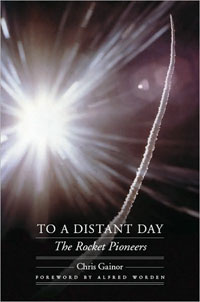|
|
Review: To a Distant Day
by Jeff Foust
Monday, May 12, 2008
To a Distant Day: The Rocket Pioneers
By Chris Gainor
Univ. of Nebraska Press, 2008
hardcover, 264 pp., illus.
ISBN 978-0-8032-2209-0
US$29.95
The 50th anniversary of the launch of Sputnik, as well as the array of 50th anniversaries that have followed, has provided a natural hook for new historical accounts of the beginning of the Space Age. However, in most cases, these books have focused on the proximate events leading up to, say, the launch of Sputnik or Explorer 1, with much less emphasis on earlier history, except for perhaps biographical sketches of key individuals. In To a Distant Day, Chris Gainor tries to provide a more balanced look at the people and events that laid the foundation for the opening of the Space Age.
Gainor does not go too far back in his history, starting (after a brief chapter about the prehistory of rocketry) with Tsiolkovsky, Goddard, and other key figures of the early 20th century. From there, he traces how these individual efforts—often unaware of each other’s work and thus in some cases duplicating research—evolved into government-sponsored projects for the primary benefit of militaries. Gainor recounts these efforts up through the dawn of the Space Age, ending with the launch of Yuri Gagarin in April 1961.
| It’s clear in the book’s preface that understanding the people, events, and driving forces that led to the opening of the Space Age is key to trying to understand what happened since then, particularly the perceived lack of progress since the end of the 1960s in human spaceflight. |
The book doesn’t plow much new ground in its overview of these “rocket pioneers”: Gainor relies primarily on secondary sources, such as other biographies and historical accounts of the era. Many people already familiar with at least some of the history of this period will probably not learn a lot about people like von Braun and Korolev, but may learn more about some of the lesser-known figures profiled in the book, like French astronautics pioneer Robert Esnault-Pelterie. Even for some of the more well-known figures, Gainor unearths a few nuggets: for example, Goddard did not strongly react to the now-infamous 1920 New York Times editorial about him because he was used to seeing scientific errors in the press and, over the long term, had a good relationship with the paper.
There isn’t necessarily a central unifying argument behind To a Distant Day, although it’s clear in the book’s preface that understanding the people, events, and driving forces that led to the opening of the Space Age is key to trying to understand what happened since then, particularly the perceived lack of progress since the end of the 1960s in human spaceflight. If you’re already familiar with much of the history of the decades leading up to Sputnik, there won’t be much new here, but for those looking for a little more historical background to the seminal events of a half-century ago, To a Distant Day is a good place to find it.
Jeff Foust (jeff@thespacereview.com) is the editor and publisher of The Space Review. He also operates the Spacetoday.net web site and the Space Politics and Personal Spaceflight weblogs. Views and opinions expressed in this article are those of the author alone, and do not represent the official positions of any organization or company, including the Futron Corporation, the author’s employer.
|
|
